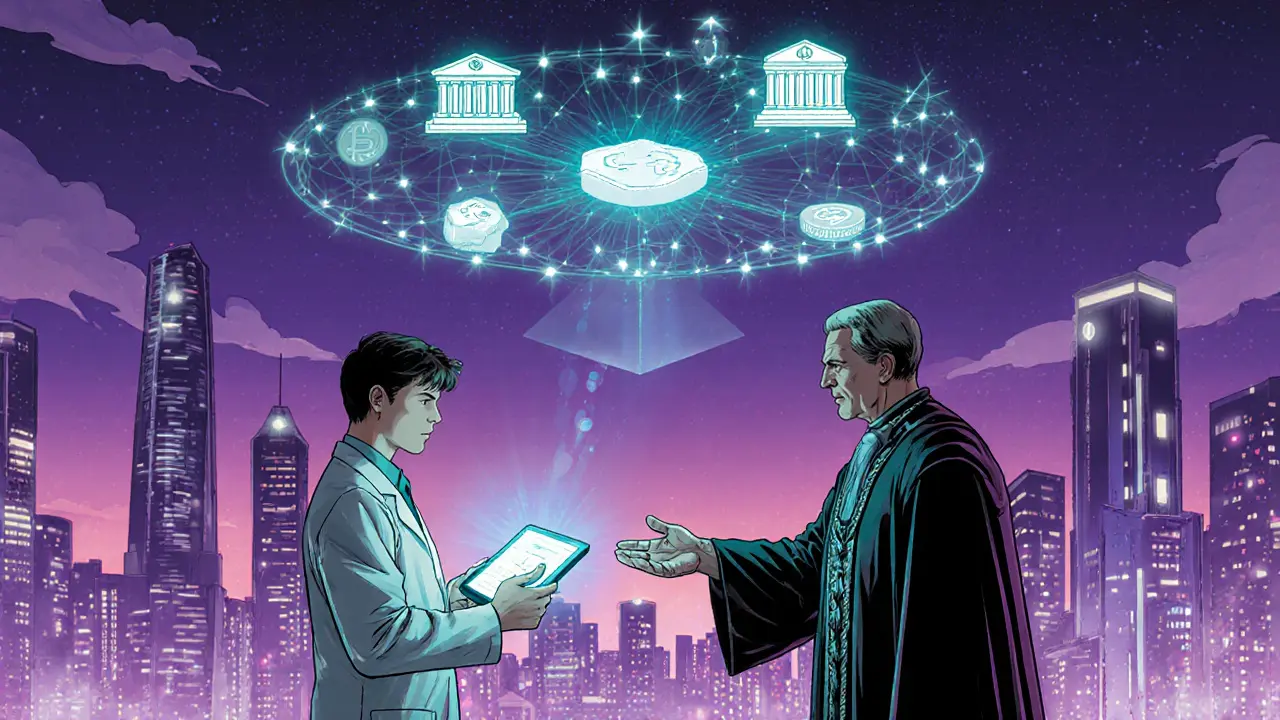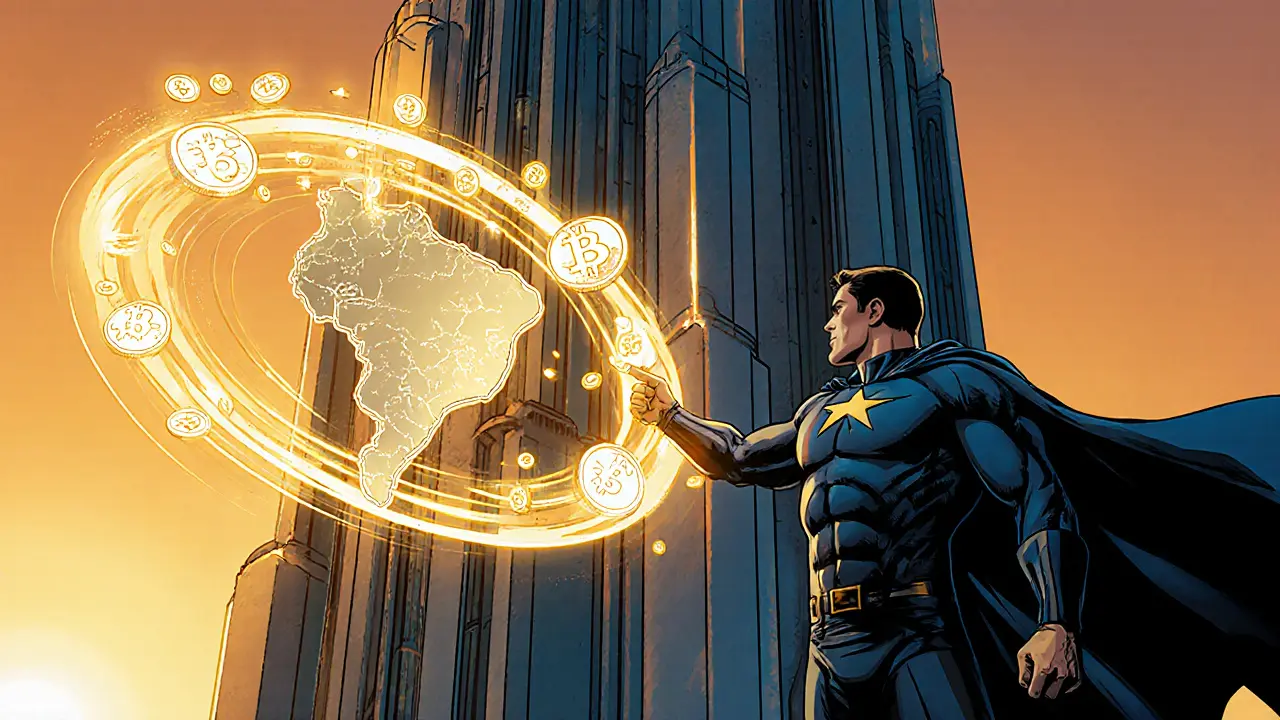Brazil Crypto Compliance Checker
Check Your Compliance Status
Compliance Summary
Key Regulations Overview
- Brazilian Virtual Assets Law (BVAL) 2022
- Decree 11,563/2023 2023
- DeCripto Reporting System 2025
- $10,000 Forex Cap 2025
- DREX Platform 2025
When it comes to digital assets in Brazil, Central Bank of Brazil is the authority that regulates, authorizes, and supervises cryptocurrency service providers under the latest legal framework. If you’ve been wondering how the country moved from a gray‑area market to a fully regulated ecosystem, you’re in the right place. This guide walks through the core rules, the paperwork you’ll need, the innovative DREX platform, and what the new forex cap means for everyday traders.
Brazil’s Crypto Regulatory Landscape in a Nutshell
In June 2023 Brazil rolled out the Brazilian Virtual Assets Law (BVAL), officially known as Federal Law No. 14.478/2022. The law handed the Brazilian Virtual Assets Law (BVAL) to the Central Bank, making it the single point of contact for crypto‑related activities. Before BVAL, the market operated with little oversight, which attracted both innovators and scammers. Today the Central Bank’s agenda, backed by Decree No. 11,563/2023, forces every Virtual Asset Service Provider (VASP) to register, follow strict AML/KYC rules, and submit detailed transaction reports.
Key Legislation: BVAL and Decree 11,563/2023
The Decree No. 11,563/2023 is the operational hand‑off that tells VASPs exactly how to comply. It outlines registration steps, data‑retention periods, and the technical standards for real‑time monitoring. Think of BVAL as the law that says “crypto needs rules,” and Decree 11,563 as the instruction manual that says “here’s how you follow those rules.” Both documents were drafted after extensive public consultations, which means the Central Bank considered industry feedback before finalizing the text.
Registration & Compliance Obligations for VASPs
Getting on the Central Bank’s registry isn’t a quick click‑through. Providers must:
- Submit a formal application that includes corporate documents, ownership structures, and a detailed business plan.
- Implement AML/KYC solutions that can flag suspicious activity within 24hours of detection.
- Store all transaction data for a minimum of five years, in a format that can be accessed by the Financial Activities Control Council (COAF).
- Integrate the Declaration of Crypto Assets (DeCripto) reporting module, which automatically pushes daily transaction summaries to the Central Bank’s monitoring system.
For newcomers, the learning curve can stretch 6‑12months, especially when you factor in the need for dedicated compliance staff and sophisticated software stacks.

Forex Cap, Stablecoin Rules, and DeCripto Reporting
In 2025 the Central Bank added a $10,000 cap on international transfers involving crypto assets. This cap forces exchanges to prioritize domestic BRL‑based trading pairs and to limit cross‑border flows. If you tried to move $15,000 worth of Bitcoin to an overseas wallet, the platform would split the transaction or require additional justification.
Stablecoins-tokens pegged to fiat-face the strictest scrutiny. Even though they represent roughly 90% of Brazil’s crypto volume, the Central Bank treats them as quasi‑fiat instruments and demands higher capital reserves from issuers.
The DeCripto system, launched in March 2025, acts like a digital audit trail. Every buy, sell, or transfer must be logged and transmitted to the Central Bank in near‑real‑time. Failure to report triggers automatic alerts to COAF and can result in hefty fines.
Innovation Tools: Sandbox & DREX Platform
Brazil isn’t just tightening rules; it’s also offering a sandbox for experimental services. Approved participants can test novel products-like tokenized loans or automated market‑making bots-under a temporary waiver of some compliance deadlines. The sandbox provides a safe space for fintechs to iterate while the Central Bank keeps a close eye on systemic risk.
Alongside the sandbox, the Central Bank is rolling out the DREX platform. DREX is a distributed‑ledger infrastructure designed for tokenized bank deposits, government securities, and loan instruments. Importantly, DREX is not a Central Bank Digital Currency (CBDC); it’s a permissioned ledger that lets banks issue digital claims on existing assets. Pilot projects with major Brazilian banks are already showing faster settlement times and reduced reconciliation costs.
Impact on Exchanges and Market Participants
Brazilian exchanges have reshaped their business models to survive the new regime. Most are now:
- Focusing on BRL‑denominated trading pairs to dodge the $10,000 transfer cap.
- Investing heavily in AML software that can handle both crypto and traditional fiat flows.
- Running user‑education campaigns that explain the DeCripto reporting obligations.
International platforms looking to enter Brazil must either partner with a local VASP or set up a Brazilian subsidiary that meets the registration criteria. The compliance cost can run into six figures for a midsize exchange, but the upside is access to a market of over 120million people, many of whom already use digital wallets.
Practical Compliance Checklist
- Register with the Central Bank using the online portal; keep the registration certificate handy.
- Deploy an AML/KYC system that meets COAF’s 24‑hour suspicious‑activity reporting requirement.
- Integrate the DeCripto API to send daily transaction summaries.
- Set internal limits to ensure no single international crypto transfer exceeds $10,000 without additional approval.
- If offering stablecoins, maintain the required capital reserves and submit a separate stability‑report quarterly.
- Consider joining the sandbox if you plan to launch a novel tokenized product; it can shave months off the compliance timeline.
- Stay updated on the upcoming stablecoin guidelines expected by the end of 2025.
Following this list keeps you on the right side of the Central Bank and reduces the risk of costly enforcement actions.

Frequently Asked Questions
Do I need a separate crypto license in Brazil?
No. The Central Bank does not issue a distinct “crypto license.” Instead, any company providing crypto services must register as a VASP under Decree 11,563 and comply with the BVAL requirements.
How does the $10,000 forex cap affect everyday users?
If you try to send more than $10,000 worth of crypto abroad in a single transaction, the exchange must split the transfer or ask for additional compliance documentation. Most users now keep their crypto activity within Brazil’s borders.
What is the sandbox and who can join?
The sandbox is a regulated testing environment where fintechs can pilot new crypto‑related services under temporary relaxed compliance rules. Applicants must be approved by the Central Bank and provide a detailed prototype description.
Is DREX a CBDC?
No. DREX is a permissioned distributed‑ledger platform for tokenizing existing bank deposits, loans, and government securities. It does not create a new sovereign digital currency.
What penalties exist for non‑compliance?
The Central Bank can impose fines up to 20% of a company’s monthly revenue, suspend registration, or refer cases to COAF for criminal investigation. Re‑registration after a sanction can take months.


Karl Livingston
December 12, 2024 AT 09:05The Brazilian Central Bank's new framework really shifts the compliance landscape. I can see smaller startups feeling the pressure to upgrade AML tools, but it also opens doors for fintechs that can adapt quickly. The sandbox vibe feels like a safety net for innovators.
Kyle Hidding
December 15, 2024 AT 18:43Brazil’s 2025 crypto policy represents a convergence of regulatory rigor and systemic risk mitigation, effectively operationalizing the BVAL provisions through Decree 11,563. The mandatory VASP registration creates a unified data repository that enhances COAF’s forensic capabilities, while the real‑time DeCripto reporting pipeline enforces transaction transparency at the ledger level. By imposing a $10,000 forex cap, the Central Bank artificially segments liquidity flows, compelling exchanges to prioritize domestic BRL pairings and thereby reducing outbound capital flight risk. Stablecoin issuers are subject to heightened capital adequacy ratios, which aligns their reserve structures with Basel‑III liquidity standards and curtails the potential for peg instability. The sandbox mechanism functions as an experimental sandboxed enclave, granting temporary regulatory flexibilities that accelerate product‑market fit cycles for tokenized securities. DREX, as a permissioned distributed‑ledger infrastructure, leverages consensus algorithms to settle inter‑bank claims within seconds, outperforming traditional RTGS timelines. Integration of DREX with legacy core banking systems necessitates API middleware that adheres to ISO‑20022 messaging schemas, a non‑trivial engineering endeavor. Compliance cost escalations are quantified at upwards of six figures for mid‑size exchanges, reflecting the cumulative burden of AML software licensing, legal counsel, and system integration. However, market access to over 120 million potential users justifies the capital outlay for entities seeking to capture Brazil’s burgeoning digital wallet adoption rates. Enforcement mechanisms include tiered fines calibrated to a percentage of monthly revenues, with escalation pathways that can lead to registration suspension and criminal referrals. The regulatory architecture thus establishes a deterrent matrix that incentivizes proactive compliance rather than reactive remediation. From a macro‑economic perspective, the policy aims to embed crypto activities within the formal financial sector, thereby expanding the tax base and enhancing monetary policy transmission. Critics argue that the forex cap may stifle cross‑border arbitrage opportunities, yet the Central Bank contends that such controls are essential to safeguard currency stability. In practice, exchanges will likely implement internal transfer limits and automated split‑transactions to navigate the cap efficiently. The overall regulatory roadmap indicates a trajectory toward greater institutional legitimacy for digital assets in Brazil. Stakeholders should therefore allocate resources toward compliance scaffolding, sandbox participation, and DREX integration to remain competitive.
Andrea Tan
December 19, 2024 AT 04:22The guide breaks down the registration steps nicely, which is helpful for anyone just starting out. I appreciate the clear checklist; it feels like a practical to‑do list rather than a legal maze. The section on DREX demystifies a lot of the buzz around tokenized deposits.
Robert Eliason
December 22, 2024 AT 14:00i cant beleive they cap forex at ten thousand.
Cody Harrington
December 25, 2024 AT 23:39From a collaboration standpoint, the sandbox offers a low‑risk environment to prototype token‑backed lending products. Teams can iterate quickly while still adhering to a baseline of AML standards, which reduces the overall time to market. It’s a sensible compromise between innovation and oversight.
Chris Hayes
December 29, 2024 AT 09:17The enforcement penalties are steep, so firms should treat compliance as a core business function, not an afterthought. Aligning internal policies with COAF expectations will save headaches down the line.
Rae Harris
January 1, 2025 AT 18:56While the policy’s intention is clear, the $10,000 cap feels arbitrary and could push volume into unregulated offshore channels. A more graduated threshold might have balanced risk without choking liquidity.
Danny Locher
January 5, 2025 AT 04:34What stands out is the sandbox’s flexibility; it lets projects test real‑world use cases without the full compliance burden upfront. This could be a game‑changer for smaller fintechs aiming to scale.
Emily Pelton
January 8, 2025 AT 14:13Exactly-leveraging the sandbox requires a meticulous project charter; you must define scope, risk parameters, and contingency plans before the Central Bank signs off. Documentation should be exhaustive, covering AML controls, data‑retention policies, and governance frameworks; otherwise the waiver can be revoked on technicalities. Also, keep a dedicated compliance liaison on‑call to address any audit queries within the 24‑hour window mandated by COAF.
sandi khardani
January 11, 2025 AT 23:51The cost‑benefit analysis of engaging with the Brazilian regulatory regime must incorporate both tangible and intangible factors. Tangible costs include licensing fees, system upgrades, and legal counsel, while intangible costs encompass market perception and operational friction. Moreover, the $10,000 forex cap introduces a non‑linear constraint on cross‑border arbitrage strategies, compelling firms to redesign liquidity provisioning mechanisms. When modeling cash flow projections, the stochastic nature of transaction volume under the cap can be represented using a truncated Poisson distribution, which more accurately captures the truncation effect imposed by the cap. Additionally, the requirement for five‑year data archival necessitates robust storage solutions, potentially leveraging cloud‑based immutable ledger services to satisfy both durability and auditability. From a risk management perspective, the amplified capital reserve requirements for stablecoin issuers elevate the balance sheet leverage ratios, thereby influencing the firm’s credit metrics. In sum, a multi‑dimensional evaluation that integrates regulatory compliance, financial engineering, and strategic positioning will yield a more informed decision on market entry.
Darren R.
January 15, 2025 AT 09:30We are standing at a moral crossroads, where the state's grip on digital sovereignty collides with the anarchic spirit of cryptographic liberty; the Brazilian Central Bank's decree is nothing short of a manifesto for control. Yet, in the grand theatre of finance, such regulatory scripts are merely acts in an ever‑evolving drama, demanding both reverence and rebellion.
Hardik Kanzariya
January 18, 2025 AT 19:08Your poetic framing captures the tension beautifully; for practitioners, the key is to turn that drama into disciplined action by building compliance pipelines that are both robust and adaptable. Embrace the process as a learning journey and your team will thrive within the new framework.
Adetoyese Oluyomi-Deji Olugunna
January 22, 2025 AT 04:47The jurisprudential nuances of BVAL are, in my humble opinion, a testament to Brazil’s burgeoning regulatory sophiscation, albeit riddled with occasional lexical ambiguities.
Krithika Natarajan
January 25, 2025 AT 14:25Indeed, the law’s language can be dense, but the core requirements are straightforward: register, report, and retain data.
Irene Tien MD MSc
January 29, 2025 AT 00:04One can’t help but wonder whether the $10,000 cap is really about financial stability or a covert attempt by shadowy global banking elites to reroute crypto capital into their clandestine offshore vaults; the timing aligns suspiciously with the rollout of DREX, a platform that, on the surface, promises efficiency but could also serve as a backdoor for data harvest by state‑aligned actors. The sandbox, while marketed as an innovation incubator, might actually be a controlled lab where regulators test surveillance tools under the guise of regulatory leniency. In this light, every transaction report filed through DeCripto could be aggregated into massive datasets, feeding predictive algorithms that anticipate market moves and manipulate liquidity. It’s a classic playbook: legitimize oversight, then weaponize the very data you once promised to protect.
kishan kumar
February 1, 2025 AT 09:42The architectural design of DREX aligns with permissioned ledger principles, employing consensus mechanisms that ensure immutability without exposing public network vulnerabilities. Such a construct facilitates tokenized issuance of sovereign debt while preserving regulatory oversight.
Anthony R
February 4, 2025 AT 19:21Indeed, the permissioned nature of DREX mitigates the typical trust‑less concerns associated with public blockchains; however, it also imposes governance frameworks that must be meticulously defined to prevent centralization of control.
Kevin Fellows
February 8, 2025 AT 04:59All in all, if you’re thinking about launching a crypto service in Brazil, start early on the compliance paperwork and consider the sandbox as your shortcut to market.